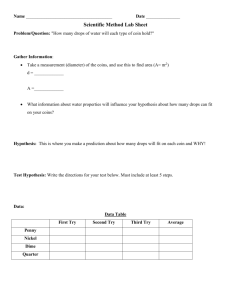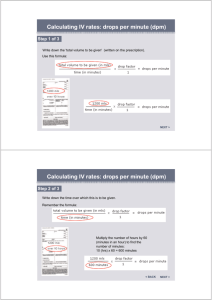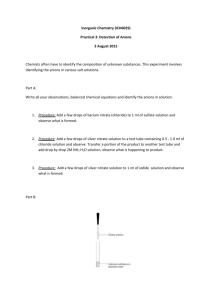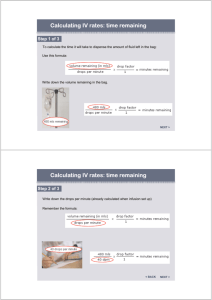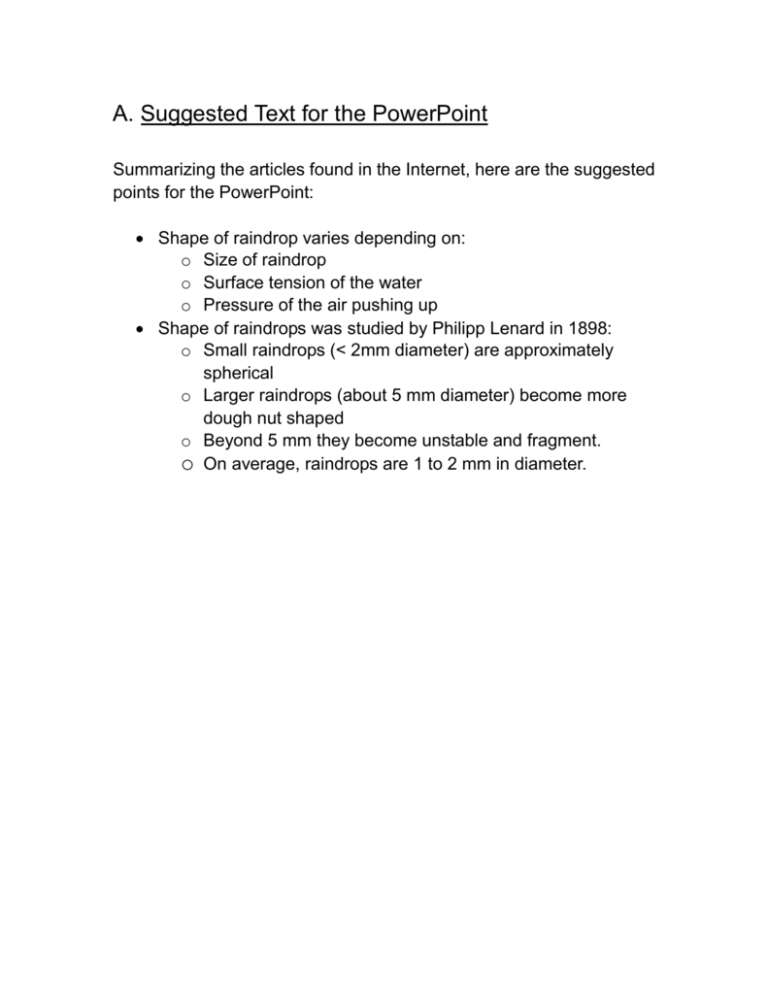
A. Suggested Text for the PowerPoint
Summarizing the articles found in the Internet, here are the suggested
points for the PowerPoint:
Shape of raindrop varies depending on:
o Size of raindrop
o Surface tension of the water
o Pressure of the air pushing up
Shape of raindrops was studied by Philipp Lenard in 1898:
o Small raindrops (< 2mm diameter) are approximately
spherical
o Larger raindrops (about 5 mm diameter) become more
dough nut shaped
o Beyond 5 mm they become unstable and fragment.
o On average, raindrops are 1 to 2 mm in diameter.
Articles Reviewed
B.
1. Rain
http://en.wikipedia.org/wiki/Rain_drop
The shape of raindrops was studied by Philipp Lenard in 1898.
o He found that small raindrops (less than about 2 mm diameter) are
approximately spherical.
o Larger (to about 5 mm diameter) they become more dough
nut-shaped.
o Beyond about 5 mm they become unstable and fragment. On
average, raindrops are 1 to 2 mm in diameter.
Falling raindrops are often depicted in cartoons or anime as
"teardrop-shaped" but this is incorrect.
Small raindrops are nearly spherical.
Larger ones become increasingly flattened on the bottom, like hamburger
buns;
very large ones are shaped like parachutes.[1]
2.
Raindrop Shape: No More Tears, Keith C. Heidorn
http://www.suite101.com/article.cfm/science_sky/91232
In truth, raindrops are spherical in shape when they begin to fall.
Unless they are very small, they take on shapes with flattened bases and rounded tops, looking
more like falling hamburger buns than teardrops, as they fall.
The distortion from the spherical drop is caused by the air resistance against the drop as it descends,
which flattens the lower drop surface.
This aerodynamic drag force can further deform large drops into sagging dumbbell shapes, causing
the biggest ones to eventually split into two or more smaller drops.
As the drops change their size (their volume), they jiggle, joggle and wobble through a variety of
spherical distortions because:
o
o
o
o
are many collisions among raindrops
cause distortions in the drops' shapes
cause drops to coalesce, forming a larger drop
cause drops to break apart into smaller drops
3.
Bad Meteorology: Raindrops are shaped like teardrops.
http://www.ems.psu.edu/~fraser/Bad/BadRain.html
Small raindrops (radius < 1 mm) are spherical;
larger ones assume a shape more like that of a hamburger bun.
larger than a radius of about 4.5 mm they rapidly become distorted into a shape rather like
a parachute with a tube of water around the base --- and then they break up into smaller
drops.
This remarkable evolution results from a tug-of-war between two forces:
o
o
the surface tension of the water
the pressure of the air pushing up against the bottom of the drop as it falls.
These are cross-sections through the drop. Imagine spinning the drop through a vertical
axis to see the real shape. So, what looks like some teardrops in the final illustration on the
right is actually closer to being a tube of liquid just before it breaks up into small spherical
droplets again.
4.
If Clouds are NOT Lighter than Air, How Do They Stay Up?
by Steve Horstmeyer, Meteorologist, WKRC TV, Cincinnati, OH
http://www.shorstmeyer.com/wxfaqs/float/float.html
The teardrop shape is a common public mis-conception.
Rain drops deform (change shape) when falling, larger drops deform more and look like
the caps of mushrooms.
Larger drops may be broken into smaller drops as they fall due to turbulence.
Rain drops often evaporate as they fall, the drop gets smaller slowing the fall.
© 1998 Steven L. Horstmeyer, all rights reserved
5. A wind tunnel investigation of the internal circulation and shape of
water drops falling at terminal velocity in air
http://www3.interscience.wiley.com/cgi-bin/abstract/114027848/ABSTRACT?CRETRY=1&SRET
RY=0
H. R. Pruppacher, K. V. Beard
Cloud Physics Laboratory, University of California, Los Angeles
Funded by:
Atmospheric Sciences Section, National Science Foundation, NSF; Grant Number: GA-759
Abstract
The internal circulation and the shape of water drops falling at terminal velocity in air of 20°C at
sea level pressure, and nearly water saturated, were studied by means of a wind tunnel. Drops
with an equivalent radius a0 smaller than 140 üm had within the experimental error no detectable
deformation from spherical shape. Drops of sizes 140
m
a0
500
m were slightly deformed
into an oblate spheroid. The deviation of these drops from spherical shape was found to be in fair
agreement with that theoretically predicted by Imai (1950) and others. The deformation of drops of
sizes 0.5 mm < a0 < 4.5 mm was found to be linearly related to the drop size. Such a linear
relationship is predicted by the semi-empirical calculations of Savic (1953).
By means of a tracer technique it was established that water drops falling at terminal velocity in air
have a well developed internal circulation. The flow pattern inside a drop was found to be
consistent with the flow pattern of the air around the drop and that predicted theoretically by
Hadamard (1911) and by Hamielec and Johnson (1962). The surface velocity at the equator of a
drop was found to be about 1/100 of the drop's terminal velocity. The experimentally determined
internal velocities were compared with those predicted theoretically by McDonald (1954) from
boundary layer theory and by Hadamard (1911) based on Stokes flow.
Received: 11 August 1969; Revised: 8 December 1969
6. Drop shape and erosivity part I: Experimental set up, theory,
and measurements of drop shape
http://www3.interscience.wiley.com/cgi-bin/abstract/112716360/ABSTRACT
Gerrit F. Epema, Hans Th. Riezebos
Laboratory of Physical Geography, State University Utrecht, P.O. Box 80.115, 3508 TC Utrecht,
The Netherlands
Keywords
Rain simulation • Drop shape • Erosivity factors
Abstract
Simulated raindrops falling in still air have a shape that is mainly determined by surface tension
and hydrostatic pressure. Drops released from capillary tips show an initial shape variation ranging
from prolate to oblate but eventually this oscillation is damped. At terminal velocity drops have
attained equilibrium and have an oblate shape. Measurements of the shape of simulated rain
drops produced by capillary tubes were made using a simple, newly-developed photographic set
up. The measurements showed that models describing the oscillation frequency and amplitude of
drops falling at terminal velocity can also be applied to the simulated drops. A comparison is made
between the shape of raindrops in natural storms and simulated drops. Recommendations are
given regarding fall heights in simulation in relation to the drop shape in nature.
Drop shape and erosivity part I: Experimental set up, theory, and measurements of drop
shape
Earth Surface Processes and Landforms
Volume 9, Issue 6, Date: November/December 1984, Pages: 567-572
Gerrit F. Epema, Hans Th. Riezebos
References:
1.
Rain
http://en.wikipedia.org/wiki/Rain_drop
2.
Raindrop Shape: No More Tears, Keith C. Heidorn
http://www.suite101.com/article.cfm/science_sky/91232
3.
Bad Meteorology: Raindrops are shaped like teardrops.
http://www.ems.psu.edu/~fraser/Bad/BadRain.html
4. If Clouds are NOT Lighter than Air, How Do They Stay Up?
http://www.shorstmeyer.com/wxfaqs/float/float.html
5. A wind tunnel investigation of the internal circulation and shape of
water drops falling at terminal velocity in air
http://www3.interscience.wiley.com/cgi-bin/abstract/114027848/ABSTRACT?CRETRY=1&S
RETRY=0
6. Drop shape and erosivity part I: Experimental set up, theory, and
measurements of drop shape
http://www3.interscience.wiley.com/cgi-bin/abstract/112716360/ABSTRACT


